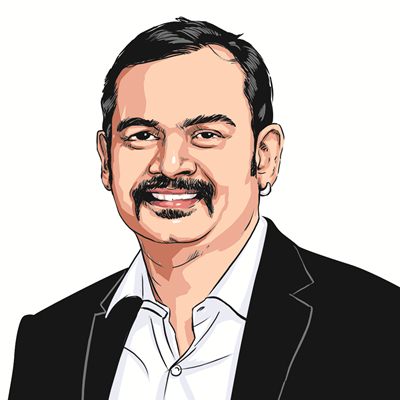The Modi Govt completes 8 years today. Since returning to power in 2019, it has checked several key boxes on its agenda. India appears to have put the worst of the pandemic behind, but multiple challenges loom at home and abroad for the remainder of the Government’s second term.
ECONOMY: Hope and challenge
India is seen to be the world’s fastest-growing big economy in FY23, with a realistic chance of holding on to that badge for a while as a botched zero-Covid policy threatens to derail the Chinese economy. But some of the structural issues that constrained the Indian growth story before the pandemic continue to weigh heavy amid a worsening inflationary spiral and an uncertain external environment.
Over the past 24 months, India has pivoted away from its otherwise insular trade stance, with pacts signed with UAE and Australia, and negotiations initiated with EU and UK. A reboot in efforts to leverage the digital infrastructure founded on the innovative UPI platform is underway, as well as further fostering of a start-up scene that has thrown up over 100 unicorns.
The big work in progress is the Centre’s attempt at replacing 29 sets of labour laws by four broad labour codes, but implementation is behind schedule. The insolvency resolution process under IBC is seeing delays. The GST structure remains an issue; much of the buoyancy in collections is on account of compliance efforts. A manufacturing-led push relies primarily on production linked incentives, but beyond telecom hardware, the output is underwhelming. The 5G telecom push likely later this year could be key to the next wave of digitisation. Commercial mining in coal has been cleared, but output is constrained.
The absence of a data protection framework is a hurdle in leveraging the numerous digital projects underway. Private investment continues to underperform, and attempts at forced formalisation have hit MSMEs. Land and agri reforms remain pending. The consumption story, despite the post-Covid recovery, continues to totter. Cleavages in spending by the rich and poor could be worsened by prolonged high inflation. Air India and LIC have given disinvestment a boost, but the big-ticket privatisation of BPCL has fallen through.
EDUCATION: National Policy, new entrance
After a sluggish first two years in the government’s second term, much been happening on the education front in recent months.
After the announcement of the new National Education Policy in July 2020, its implementation got off to a sluggish start, mainly due to the pandemic. Now, there’s a common entrance test for admission to central universities. Students can study a four-year multidisciplinary undergraduate programme with multiple exit options, or even two degree programmes simultaneously. The UGC now permits students to pursue up to 40% of a programme online. But some announcements have been more cosmetic: for example, the midday meal scheme has been repackaged and renamed PM POSHAN without any additional allocation.
A committee has been set up for drafting the National Curriculum Framework with guidelines for changes in the school curriculum. The NCF is expected to be ready by next year. For a single regulator for higher education, a Bill to set up the Higher Education Commission of India is almost ready.
Appointment of teachers remains tardy; the National Research Foundation announced in 2019 hasn’t been set up yet; and public spending on education is nowhere near the 6% of GDP promised in 2014 and has in fact been decreasing. Apart from IIMs, none of the other centrally-run institutions have been granted total autonomy; and not even 20 of the 50 Institutions of Eminence promised by the BJP have been set up.
SOCIAL SECTOR: Rise of the Labharthi
Leveraging the Jan Dhan-Aadhaar-Mobile (JAM) platform to expand coverage of the flagship PM-Kisan scheme from 1 crore beneficiaries in February 2019 to over 10 crore in January 2022, new initiatives like PM-GKAY to provide free foodgrain to nearly 80 crore people, and retreating with a bloody nose from the battle to reform the agriculture sector — these have been the social sector headlines of Modi 2.0 so far.
10 instalments of PM-Kisan have been released so far — Rs 1.80 lakh crore has been transferred directly into farmers’ accounts. The 11th installment is due for release on May 31. PM-Ujjwala beneficiaries have gone from 8 crore in September 2019 to 9 crore in April 2022. Pradhan Mantri Garib Kalyan Anna Yojana, launched in response to the pandemic in February 2020 to provide 5 kg free foodgrains to 81.35 crore people every month, has been extended till September 2022. The Centre has also been able to roll out the One Nation, One Ration Card (ONORC) project to enable NFSA beneficiaries to avail of their entitlement anywhere in India.
The flagship Jal Jeevan Mission, launched in the government’s second term, aims to provide tap water connections to all rural households by 2024. The Jal Shakti Ministry said on Saturday that 50% rural households had already been covered. If implemented fully and successfully, Jal Jeevan will be a scheme of gamechanging impact.
The withdrawal, in November 2021, and eventual repeal by Parliament of the three farm laws announced in June 2020 are both a setback and an unfinished agenda point for the government. Experts have argued that reform is critical to the advancement of Indian agriculture.
DIPLOMACY & STRATEGY: Tightrope and partnerships
New Delhi’s diplomatic outreach succeeded in blunting international criticism of the constitutional changes in Jammu and Kashmir early on, and significant strategic achievements have followed. But the neighbourhood remains in turmoil, and China presents a huge challenge.
With an experienced diplomat at the helm, Modi 2.0 began by explaining to the world its decision to abrogate Art 370 that revoked the special status for Jammu and Kashmir. The transition from the Trump administration to the one led by President Joe Biden was smooth, and the strengthening of the Quad was a significant achievement. The framing of an Indo-Pacific strategy by European partners including France, Germany, UK, and EU is a positive for India’s interests, as China is seen as a violator of the global rules-based order. India’s Covid diplomacy largely worked, albeit with some challenges of supply.
The amendment to the citizenship law set the cat among the pigeons, and New Delhi had to reach out to Dhaka to assuage concerns. The strategic establishment has been occupied with diplomacy with Beijing, as the two-year border stand-off poses the most serious threat of recent times. The war in Ukraine has made it difficult for New Delhi to continue deep engagement with defence partner Russia. The balancing act has been successful so far, but remains a delicate work in progress, as do engagements with China and the neighbourhood.
Taliban-ruled Afghanistan presents a huge strategic challenge. New governments are in power in Myanmar, Nepal, Pakistan, and Sri Lanka, and the latter two nations are in economic and political crises. New Delhi has to navigate its ties with its neighbours and help maintain a peaceful and stable South Asia. Its leadership in the subcontinent will be tested in the near future.
POLITICS: BJP growing, concerns remain
In its second term, the BJP has made strides towards achieving its ideological agenda and consolidated its position as the major pole of national politics. But it remains challenged by regional parties, a struggling economy, and a communally charged atmosphere.
In the last years, the BJP has made itself and its ideology the major pole of Indian politics. With the key missions in its ideological agenda – the construction of Ram Temple in Ayodhya and abrogation of Article 370 — already achieved, the ban on triple talaq is being seen as progress halfway towards a Uniform Civil Code. The party is slowly and cautiously embarking on a new mission on Kashi and Mathura temples, but it is a legislative agenda.
Although the BJP has become a dominant political force at the national level, regional parties still call the shots in a number of southern and eastern states. The party is working on a blueprint to alter the “political and ideological character” of these states.
There has been very little progress in restoring the electoral process in Jammu and Kashmir, and the reopening of the Kashi and Mathura disputes has put paid to hopes of impending closure in these cases following the resolution of the Ram Janmabhoomi matter in favour of the Hindu side. The ‘bulldozer politics’ in several states has enhanced insecurities among the minorities and opened the government up to allegations of partisan behaviour. Satisfactorily addressing all of these dissonances remains a task before the government and party in line with the Prime Minister’s promise of “sabka vishwas”. Unemployment too remains a concern.
HEALTH: Vaccines for all, but work to do
Most of government’s time and resources in the last two years have been consumed in responding to the pandemic, which has in turn exposed India’s fragile healthcare infrastructure.
Just before the pandemic, the government had unveiled its plan to create an elaborate network of health and wellness centres (HWCs) for delivery of primary healthcare. About 1.5 lakh HWCs are proposed to be set up. An initiative to provide a unique health ID to every citizen and create a registry of healthcare professionals and health facilities has also been launched. In providing Covid-19 vaccines to everyone, India has done better than most other countries.
Most of the health initiatives, including the creation of HWCs and digital mission are works in progress. So are programmes like the Jan Arogya Yojana for insurance to the poor. Barely 5% of India’s population has health insurance right now, which makes the Jan Arogya Yojana a very important initiative.
The government still has a long way to go in providing universal and affordable access to healthcare facilities. The partnership of state governments is vital. Upgrading of infrastructure, reforms in medical education, expansion of nursing and para-medical education, and regulation of costs of healthcare are some of the big projects the government has to attend to.
Buy Now | Our best subscription plan now has a special price
SECURITY & DEFENCE: LWE in decline, reforms pending
On the security front, the performance of the government has been a mixed bag in the last eight years..
According to Ministry of Home Affairs, Left Wing Extremism-related violence has declined by 77% between 2009 and 2021, and resultant deaths by 85% between 2010 and 2021. The geographical influence of Maoists has been reduced to just 41 districts from 96 in 2010. Gains have also been made in the Northeast
The creation of the post of the Chief of Defence Staff was a key reform, but work appears to have stalled. After CDS General Bipin Rawat was killed in a helicopter crash in December, the position is still vacant. Also, theaterisation in the armed forces isn’t working at the desired pace.
Terror emanating from Pakistan remains a cause for concern. Despite the government’s claims of normalcy in Jammu and Kashmir following abrogation of its special status on August 5, 2019, a rise in civilian killings has posed questions. Also, as many as 25 modules of Khalistan militancy were identified and neutralised by security forces in 2021, compared to 15 in 2020 and just seven in 2019.
🗞 Subscribe Now: Get Express Premium to access our in-depth reporting, explainers and opinions 🗞️
For all the latest Explained News, download Indian Express App.

 Deeptiman Tiwary… read more
Deeptiman Tiwary… read more

 Liz MathewHave been in journalism covering national politics for 23 years. Have … read more
Liz MathewHave been in journalism covering national politics for 23 years. Have … read more

 Shubhajit Roy… read more
Shubhajit Roy… read more

 Harikishan Sharma… read more
Harikishan Sharma… read more

 Anil SasiAnil Sasi is National Business Editor with the Indian Express and writ… read more
Anil SasiAnil Sasi is National Business Editor with the Indian Express and writ… read more






